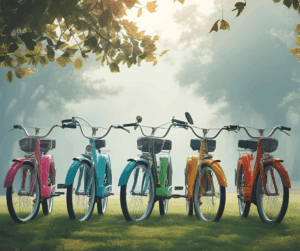If you’re new to the world of bikes, the process of buying your first one can be both exciting and overwhelming. With so many models, features, and styles available today, it’s easy to feel lost. But don’t worry — this guide is here to simplify everything. Whether you’re looking for a reliable commuting option or just want to explore your neighborhood on two wheels, understanding your choices is the key to a successful purchase.
Why Choose a Bike?
There are many reasons people decide to start riding bikes. Some want a greener alternative to cars, while others see it as a fun way to exercise. Bikes provide freedom, flexibility, and cost-effective travel. Unlike motor vehicles, bikes don’t require petrol, expensive repairs, or constant parking fees. And with modern advancements in e-mobility, even e-bikes have become more accessible to new riders who want a little boost.
Step 1: Define Your Purpose
Before diving into specific models or features, think about why you’re buying a bike. This will shape every other decision. Here are some common reasons:
- Commuting to work or school: You’ll want something lightweight, durable, and potentially an e-bike for long distances.
- Weekend leisure rides: A comfort or cruiser bike might be ideal.
- Fitness goals: A road bike or hybrid bike can offer a faster ride.
- Off-road or trail riding: Mountain bikes or fat tire bikes work best.
When your goal is clear, you can narrow down the options to bikes that are purpose-built for your needs.
Step 2: Learn the Types of Bikes
The market offers a wide variety of bikes, each designed for different environments and rider preferences. Here’s a breakdown of the most popular types:
1. Road Bikes
Road bicycles are designed for speed and efficiency on paved surfaces. They have narrow tires, lightweight frames, and drop handlebars. These bikes are great if you’re planning to cycle long distances on the road or want to build endurance.
2. Mountain Bikes
Mountain bicycles are ideal for rugged terrain, including dirt paths, forest trails, and rocky inclines. They typically have suspension systems, thicker tires, and flat handlebars for better control and shock absorption.
3. Hybrid Bikes
Hybrid bikes combine the best of road and mountain bicycles. They’re perfect for urban riders who may occasionally tackle trails. These bikes offer comfort, stability, and decent speed, making them a popular choice among beginners.
4. Cruiser Bikes
Known for their laid-back style and comfortable seating, cruiser bicycles are best for beach rides or casual neighborhood spins. They’re not built for speed but offer an enjoyable and relaxed riding experience.
5. Folding Bikes
Ideal for urban commuters with limited storage, folding bicycles can be compactly stored under desks or carried onto public transport. They may not match the performance of standard bikes, but their convenience is unmatched.
6. Electric Bikes (E-bikes)
E-bicycles are increasingly popular among first-time riders. They offer pedal-assist or full-throttle options to make cycling easier. If you’re concerned about physical exertion or long commutes, e-bikes offer a powerful solution while still giving you the biking experience.
Step 3: Understand Bike Sizing
One of the most important aspects of buying a bicycle is ensuring the right fit. A bike that’s too small or too large can lead to discomfort, poor control, and even injury.
Key sizing factors include:
- Frame Size: Usually measured in inches or centimeters. It depends on your height and leg length.
- Wheel Size: Common sizes are 26″, 27.5″, and 29″ for adults. Kids’ bikes often have smaller wheels.
- Handlebar Reach and Seat Height: Adjustable on most bikes, but you should still test a few to find your ideal posture.
Many brands offer sizing charts, but nothing beats going to a physical store and trying out different bikes. A properly sized bike makes your ride safer and more enjoyable.
Step 4: Decide on Your Budget
Bikes come in a wide price range. You can find simple models under $200 or high-end bicycles that cost several thousand. For first-time riders, it’s important to strike a balance between affordability and quality.
Here’s a rough breakdown:
- $200–$500: Entry-level bicycles for casual use.
- $500–$1,000: Better materials, gearing, and comfort.
- $1,000–$2,500: Mid-range performance bikes or quality e-bikes.
- $2,500+: High-end bikes with premium components and advanced features.
Keep in mind, your budget should also consider accessories like helmets, locks, lights, and maintenance tools. Some shops offer package deals that bundle these items with the bicycle purchase.
Step 5: Test Ride Before You Buy
Whenever possible, test ride different bicycles to get a feel for what suits you. Pay attention to:
- Comfort: Are the saddle and handlebars in a natural position?
- Handling: Is the bike responsive? Does it feel stable?
- Weight: Can you lift or carry the bike easily if needed?
- Gearing and Braking: Are they smooth and intuitive?
Every rider has unique preferences, and even bicycles with similar specs can feel vastly different. Don’t rush this step.
Step 6: Choose Essential Accessories
Once you’ve chosen your bicycle, it’s time to think about must-have accessories that enhance safety and functionality. Some items are non-negotiable:
- Helmet: Always wear one, no matter how short your ride.
- Bike Lock: A good lock deters theft and keeps your bike secure.
- Lights and Reflectors: Essential for night or low-light rides.
- Bell or Horn: For alerting pedestrians and other riders.
- Bike Pump and Patch Kit: Handy tools for quick repairs on the go.
- Water Bottle and Cage: Staying hydrated during your rides is crucial.
These additions make your biking experience safer and more convenient, especially for new riders.
Step 7: Maintenance Basics
Owning a bicycle comes with some responsibility. Even low-maintenance bicycles need occasional care. Here’s what you should know:
- Check Tire Pressure Weekly: Underinflated tires can affect performance.
- Lubricate the Chain Monthly: A dry chain wears out quickly.
- Brake Check: Ensure brakes respond promptly and don’t squeak.
- General Cleaning: Wipe down your bike after wet rides to avoid rust.
Some e-mobility shops offer beginner maintenance workshops, and many bicycles today come with basic maintenance guides. Investing time in maintenance can extend your bike’s lifespan significantly.
Step 8: Consider an E-Bike
If you’re hesitant about cycling long distances or dealing with hills, an electric bicycle might be the right fit. E-bicycles come in various types — from mountain-style to commuter designs — and offer several advantages:
- Effortless Climbing: Perfect for hilly areas or windy conditions.
- Extended Range: Travel longer without getting exhausted.
- Eco-Friendly Commuting: Combine speed and sustainability.
- Inclusive Riding: Great for people of varying fitness levels.
The e-mobility market in Singapore, for instance, has grown rapidly, and many new riders are choosing e-bicycles for their first cycling experience.
Common First-Time Mistakes (and How to Avoid Them)
Even with research, beginners can fall into some common traps. Here’s what to watch out for:
- Buying Based on Looks Alone: That matte black frame might look cool, but it might not be right for your needs.
- Ignoring the Test Ride: Comfort can’t be judged online — always try before you buy.
- Skipping Safety Gear: Always invest in quality safety equipment.
- Neglecting Maintenance: Small issues can grow into costly repairs if ignored.
- Overlooking Return or Warranty Policies: Make sure your retailer offers reasonable return terms.
By being aware of these, you’ll set yourself up for a smoother biking journey.
Final Thoughts: Your Perfect Bike Awaits
Choosing your first bicycle doesn’t need to be intimidating. By focusing on your needs, understanding the types of bicycles available, and considering essential accessories and fit, you can make a confident and informed choice. Whether you’re heading to work, chasing weekend adventures, or simply riding for the joy of it, there’s a bicycle out there for you.
The bicycles of today are more versatile and beginner-friendly than ever before. From hybrid bikes perfect for daily errands to sleek road bikes for long-distance rides and powerful e-bicycles that turn commutes into a breeze — your perfect match is just around the corner. With this ultimate bicycle buying guide in your hands, you’re more than ready to begin your journey on two wheels.





